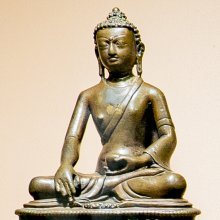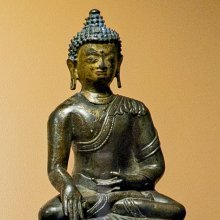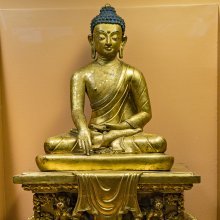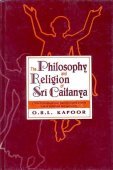Lakshana, Lakṣaṇa, Laksana, Lakṣaṇā: 41 definitions
Introduction:
Lakshana means something in Buddhism, Pali, Hinduism, Sanskrit, Jainism, Prakrit, the history of ancient India, Marathi, Hindi, biology. If you want to know the exact meaning, history, etymology or English translation of this term then check out the descriptions on this page. Add your comment or reference to a book if you want to contribute to this summary article.
The Sanskrit terms Lakṣaṇa and Lakṣaṇā can be transliterated into English as Laksana or Lakshana, using the IAST transliteration scheme (?).
Alternative spellings of this word include Lakshan.
Images (photo gallery)
(+2 more images available)
In Hinduism
Natyashastra (theatrics and dramaturgy)
Source: Wisdom Library: Nāṭya-śāstraLakṣaṇa (लक्षण) refers to “characteristic feature”. According to the Nāṭyaśāstra chapter 17, there are thirty-six lakṣaṇas (‘characteristic features’) that make a perfect poetic composition (kāvyabandha). The term is used throughout nāṭyaśāstra literature.
There are thirty-seven lakṣaṇas:
- bhūṣaṇa (the ornamental quality),
- akṣarasaṃghāta (due word combinations),
- śobhā (beauty),
- udāharaṇa (example),
- hetu (motivation),
- saṃśaya (hesitation),
- dṛṣṭānta (graphic illustration),
- prāpti (attainment),
- abhiprāya (confidence),
- nidarśana (counter-argument),
- nirukta (etymology),
- siddhi (success),
- viśeṣana (recognition),
- guṇātipāta (contrast of virtues),
- guṇātiśaya (special virtues),
- tulyatarka (persuasion through comparison),
- padoccaya (lengthy statement),
- diṣṭa (description),
- upadiṣṭa (apt statement),
- vicāra (progress),
- viparyaya (transposition),
- bhraṃśa (slip of the tongue),
- anunaya (mediation),
- mālā (garland),
- dākṣiṇya (reasonable conduct),
- garhaṇa (hypocrisy),
- arthāpatti (admission),
- prasiddhi (progress to success),
- pṛcchā (query),
- sārūpya (identity),
- manoratha (hint at a desire),
- leśa (wit),
- saṃkṣobha (affliction),
- guṇakīrtana (extolling virtues),
- anuktasiddhi (vague success),
- priyokti (pleasant speech),

Natyashastra (नाट्यशास्त्र, nāṭyaśāstra) refers to both the ancient Indian tradition (shastra) of performing arts, (natya—theatrics, drama, dance, music), as well as the name of a Sanskrit work dealing with these subjects. It also teaches the rules for composing Dramatic plays (nataka), construction and performance of Theater, and Poetic works (kavya).
Purana and Itihasa (epic history)
Source: archive.org: Puranic Encyclopedia1) Lakṣaṇā (लक्षणा).—Daughter of Duryodhana. Wife of Sāmba. (See for details under Sāmba).
2) Lakṣaṇā (लक्षणा).—A celestial maiden. This maiden took part in the birth day celebrations of Arjuna. (Śloka 62, Chapter 122, Ādi Parva, Mahābhārata).
3) Lakṣaṇā (लक्षणा).—(LAKṢMAṆĀ) III. One of the eight queens of Śrī Kṛṣṇa. Lakṣaṇā was the daughter of Bṛhatsena, King of Madra. (Sṛṣṭi Khaṇḍa, Padma Purāṇa). Śrī Kṛṣṇa got ten sons of her some of whom are Praghoṣa, Gātravān, Siṃha and Bala. (10th Skandha, Bhāgavata).
Source: Cologne Digital Sanskrit Dictionaries: The Purana Index1) Lakṣaṇa (लक्षण).—An elephant, son of Añjanā.*
- * Brahmāṇḍa-purāṇa III. 7. 339.
2) Lakṣaṇā (लक्षणा).—An Apsaras.*
- * Vāyu-purāṇa 69. 6.

The Purana (पुराण, purāṇas) refers to Sanskrit literature preserving ancient India’s vast cultural history, including historical legends, religious ceremonies, various arts and sciences. The eighteen mahapuranas total over 400,000 shlokas (metrical couplets) and date to at least several centuries BCE.
Vaisheshika (school of philosophy)
Source: Wisdom Library: VaiśeṣikaLakṣaṇa (लक्षण) means the “definition” of a topic, and refers to one of the three methods of expositions laid down in the Nyāyabhāṣya (verse 1.1.2) by Vātsyāyana.
Source: Google Books: Transactions of the Royal Asiatic Society of Great Britain and Ireland, Volume 1Definition, (lakṣaṇa) sets forth a peculiar property, constituting the essential character of a thing.

Vaisheshika (वैशेषिक, vaiśeṣika) refers to a school of orthodox Hindu philosophy (astika), drawing its subject-matter from the Upanishads. Vaisheshika deals with subjects such as logic, epistemology, philosophy and expounds concepts similar to Buddhism in nature
Vyakarana (Sanskrit grammar)
Source: Shodhganga: Vaiyākaraṇabhūṣaṇasāra: a critical studyLakṣaṇā (लक्षणा).—Faculty of indication or implication residing in a word. It subordinates or abandons the real meaning of a word and helps comprehend a different but related meaning.
Source: Wikisource: A dictionary of Sanskrit grammar1) Lakṣaṇa (लक्षण).—A rule or a sūtra composed by the ancient Sūtrakāras; the word is very frequently used in this sense by the Bhāşyakāra and later commentators; cf. लक्ष्यलक्षणे व्याकरणम् (lakṣyalakṣaṇe vyākaraṇam); cf. also लक्षणं हि नाम ध्वनति, भ्रमति मुहूर्तमपि नावतिष्ठते (lakṣaṇaṃ hi nāma dhvanati, bhramati muhūrtamapi nāvatiṣṭhate) M.Bh. on P.I.1.3 Vārt 10;
2) Lakṣaṇa.—Characteristic or sign; cf. लक्षणेनाभिप्रती आभिमुख्ये (lakṣaṇenābhipratī ābhimukhye) P. II. 1. 14; cf. also P.I.4.90 and III. 2.12;
3) Lakṣaṇa.—Indirect way of expression; cf. लक्षणप्रतिपदोक्तयोः प्रतिपदोक्तत्यैव ग्रहणम् (lakṣaṇapratipadoktayoḥ pratipadoktatyaiva grahaṇam) Par. Śek. Pari. 105.
--- OR ---
Lakṣaṇā (लक्षणा).—Implication; potentiality of implication; this potentiality of words viz. लक्षणा (lakṣaṇā) is not recognised by grammarians as a potentiality different from the अभिधाशक्ति (abhidhāśakti) or the power of denotation. Later grammarians, however, like the Ālamkārikas, have used the word in the sense of potentiality of implication as different from that of denotation; cf. अन्त्यशब्दे लक्षणा न च (antyaśabde lakṣaṇā na ca) Paribhāşenduśekhara.

Vyakarana (व्याकरण, vyākaraṇa) refers to Sanskrit grammar and represents one of the six additional sciences (vedanga) to be studied along with the Vedas. Vyakarana concerns itself with the rules of Sanskrit grammar and linguistic analysis in order to establish the correct context of words and sentences.
Kavya (poetry)
Source: archive.org: Naisadhacarita of SriharsaLakṣaṇa (लक्षण) refers to “definition”, and is mentioned in the Naiṣadha-carita 10.81.—Cf. Uddeśa (“enunciation”).

Kavya (काव्य, kavya) refers to Sanskrit poetry, a popular ancient Indian tradition of literature. There have been many Sanskrit poets over the ages, hailing from ancient India and beyond. This topic includes mahakavya, or ‘epic poetry’ and natya, or ‘dramatic poetry’.
Ayurveda (science of life)
Kalpa (Formulas, Drug prescriptions and other Medicinal preparations)
Source: Ancient Science of Life: Yogaśataka of Pandita VararuciLakṣaṇa (लक्षण) refers to “sign and symptoms”, as mentioned in the 10th century Yogaśataka written by Pandita Vararuci.—It has been told that “only after examining hetu (causative factors) and lakṣaṇa (sign and symptoms) of disease thoroughly, treatment should be prescribed. And any kind of drug or treatment can cure the disease if it is applied in nirāma (devoid of Āma) condition”.
Unclassified Ayurveda definitions
Source: gurumukhi.ru: Ayurveda glossary of termsLakṣaṇā (लक्षणा):—Specific expression indicated by a word or phrase or sentence
Source: Indian Journal of History of Science: Jvaranirnaya: a rare monograph on diagnosis of fevers from the pre-colonial eraLakṣaṇa (लक्षण) refers to the “symptoms (of fever)”, according to the Jvaranirṇaya: an Ayurvedic manuscript dealing exclusively with types of jvara (fevers) written by Sri Nārāyaṇa Paṇḍita in the 16th century CE.—The uniqueness of the text is that one can get a comprehensive classification, symptomatology and diagnosis of jvara, all at one place in this text. [...] Pṛthakjāta here means “caused by single Doṣa specifically”. The cause, prodromal symptoms, symptoms (lakṣaṇa) and types that manifests due to the involvement or vitiation of a single doṣa , two doṣa , three doṣa and fever due to extrinsic causes are mentioned in this section. This section also deals with latent fevers and the time taken for relief from different types of fevers.

Āyurveda (आयुर्वेद, ayurveda) is a branch of Indian science dealing with medicine, herbalism, taxology, anatomy, surgery, alchemy and related topics. Traditional practice of Āyurveda in ancient India dates back to at least the first millenium BC. Literature is commonly written in Sanskrit using various poetic metres.
Vaishnavism (Vaishava dharma)
Source: Pure Bhakti: Brhad BhagavatamrtamLakṣaṇa (लक्षण) refers to:—Quality or characteristic. (cf. Glossary page from Śrī Bṛhad-bhāgavatāmṛta).

Vaishnava (वैष्णव, vaiṣṇava) or vaishnavism (vaiṣṇavism) represents a tradition of Hinduism worshipping Vishnu as the supreme Lord. Similar to the Shaktism and Shaivism traditions, Vaishnavism also developed as an individual movement, famous for its exposition of the dashavatara (‘ten avatars of Vishnu’).
Shaivism (Shaiva philosophy)
Source: Brill: Śaivism and the Tantric Traditions1) Lakṣaṇa (लक्षण) refers to the “characteristics (of a temple of Śiva)”, according to the 9th-century Sarvajñānottaratantra chapter 18.—Accordingly, “Next, I shall teach the best observance among observances, which is known as the Śiva-vrata and which is revered by Asuras and Gods alike. [...] Next, I shall teach the characteristics (lakṣaṇa) of a temple of Śiva, as well as [how to perform] the installation of the liṅga, in which the universe is [itself] ‘installed.’ All the gods, beginning with Brahmā, reside in the liṅga; therefore a Yogin who venerates his guru, God and the fire and who has performed his vidyāvrata should install the liṅga, following the procedure taught in scripture. [...]”.
2) Lakṣaṇa (लक्षण) refers to “(favourable) characteristics (of a woman)”, according to the 13th-century Matsyendrasaṃhitā: a Kubjikā-Tripurā oriented Tantric Yoga text of the Ṣaḍanvayaśāmbhava tradition from South India.—Accordingly, “[Devī spoke]:—O God, what kind of a woman is a Yoginī? Who is Māyā and who is Pāśavī? Tell me, O Bhairava, the pros and cons of having sex with them. [Bhairava spoke]:—[...] A woman who possesses all favourable characteristics (sarva-lakṣaṇa-sampannā) [but] has neither a [Yoginī] Clan/noble family nor a [human/material] form/beauty, and who is to be approached by empathic imagination, O Maheśānī, is called Māyā”.

Shaiva (शैव, śaiva) or Shaivism (śaivism) represents a tradition of Hinduism worshiping Shiva as the supreme being. Closely related to Shaktism, Shaiva literature includes a range of scriptures, including Tantras, while the root of this tradition may be traced back to the ancient Vedas.
Yoga (school of philosophy)
Source: Brill: Śaivism and the Tantric Traditions (yoga)Lakṣaṇa (लक्षण) refers to the “mark (of omniscience)”, according to the Amṛtasiddhi, a 12th-century text belonging to the Haṭhayoga textual tradition.—Accordingly, “Omniscience, which brings about complete understanding of the triple body, should be known by the knowledgable to be the mark (lakṣaṇa) of he whose mind has been mastered”.

Yoga is originally considered a branch of Hindu philosophy (astika), but both ancient and modern Yoga combine the physical, mental and spiritual. Yoga teaches various physical techniques also known as āsanas (postures), used for various purposes (eg., meditation, contemplation, relaxation).
Kavyashastra (science of poetry)
Source: Shodhganga: Elements of Art and Architecture in the Trtiyakhanda of the Visnudharmottarapurana (kavya)Lakṣaṇā (लक्षणा) refers to Lakṣārtha which represents one of the “three kinds of meaning of words”, according to the Sāhityadarpaṇa.—There are three kinds of meaning of words which are: vācya-artha, lakṣa-artha and vyaṅga-artha. The vācya-artha is known by abhidhā, lakṣa-artha is known by lakṣaṇā and vyaṅga-artha is recognized by vyañjanā. Thus it can be said that Abhidhā denotes the primary meaning, where the dictionary meaning of the word is predominant. Lakṣaṇā denotes the secondary meaning which is established after the failure of the primary sense though it is based on the primary meaning. And vyañjanā denotes the suggestive sense of a word.

Kavyashastra (काव्यशास्त्र, kāvyaśāstra) refers to the ancient Indian tradition of poetry (kavya). Canonical literature (shastra) of the includes encyclopedic manuals dealing with prosody, rhetoric and various other guidelines serving to teach the poet how to compose literature.
Sports, Arts and Entertainment (wordly enjoyments)
Source: archive.org: Syainika Sastra of Rudradeva with English Translation (art)Lakṣaṇa (लक्षण) refers to the “characteristics (of hawks)”, according to the Śyainika-śāstra: a Sanskrit treatise dealing with the divisions and benefits of Hunting and Hawking, written by Rājā Rudradeva (or Candradeva) in possibly the 13th century.—Accordingly, “[Hunting by Hawking] is to be practised in various ways, namely, by inspiring the hawks with confidence, by observing their characteristics (lakṣaṇa) and by practising the different ways of throwing or casting them. The casting is of two kinds—Hastamoka and Muṣṭimoka. [...]”.

This section covers the skills and profiencies of the Kalas (“performing arts”) and Shastras (“sciences”) involving ancient Indian traditions of sports, games, arts, entertainment, love-making and other means of wordly enjoyments. Traditionally these topics were dealt with in Sanskrit treatises explaing the philosophy and the justification of enjoying the pleasures of the senses.
General definition (in Hinduism)
Source: academia.edu: Tessitori Collection I (hinduism)Lakṣaṇa (लक्षण) refer to “definitions”, according to the Alaṃkāraratnākara by Dalapatirāya and Baṃsīdhara (dealing with Poetics and Erotics). The Alaṃkāraratnākara is included in the collection of manuscripts at the ‘Vincenzo Joppi’ library, collected by Luigi Pio Tessitori during his visit to Rajasthan between 1914 and 1919.—[...] The Alaṃkāraratnākara by Vaṃsīdhara and Dalapatirāya is extensive. As stated by them, it is in the tradition of the Sanskrit kuvalayānanda. It is made of definitions (lacchana, Skt. lakṣaṇa) and examples.
In Buddhism
Tibetan Buddhism (Vajrayana or tantric Buddhism)
Source: academia.edu: A Critical Study of the Vajraḍākamahātantrarāja (II)Lakṣaṇa (लक्षण) is the name of a plant mentioned in connection with a Tantric ceremony, according to the Vajraḍākatantra chapter 38.—Five techniques to please Dūtīs as well as the Yogin himself and to enlarge a Yogin’s gentials are introduced. Various kinds of woods and plants in addition to honey and butter are utilized for this purpose. [...] If a Yogin crushes gaṇḍūṣa and lakṣaṇa (according to the commentary they are names of plants), cooks them with sesame oil and rubs it on his foot, he will be praised by Dūtīs.

Tibetan Buddhism includes schools such as Nyingma, Kadampa, Kagyu and Gelug. Their primary canon of literature is divided in two broad categories: The Kangyur, which consists of Buddha’s words, and the Tengyur, which includes commentaries from various sources. Esotericism and tantra techniques (vajrayāna) are collected indepently.
Mahayana (major branch of Buddhism)
Source: academia.edu: A Study and Translation of the GaganagañjaparipṛcchāLakṣaṇa (लक्षण) refers to a “characteristic” (Cf. Lakṣya—‘something to be characterized’), according to the Gaganagañjaparipṛcchā: the eighth chapter of the Mahāsaṃnipāta (a collection of Mahāyāna Buddhist Sūtras).—Accordingly, “Then, the Lord went on to speak these verses: ‘[...] (80) Insight purifies the root of hindrance; it is the mark of knowledge (parijñā) about the part of personality and realms (skandhadhātu); it is the liberation from its characteristics since there is no distinction between a characteristic and something to be characterized (lakṣaṇa-lakṣya). By attaining the insight, he is adorned in the three realms. [...]’”.
Source: De Gruyter: A Buddhist Ritual Manual on AgricultureLakṣaṇa (लक्षण) refers to “(thirty-two) marks (of beauty)”, according to the Vajratuṇḍasamayakalparāja, an ancient Buddhist ritual manual on agriculture from the 5th-century (or earlier), containing various instructions for the Sangha to provide agriculture-related services to laypeople including rain-making, weather control and crop protection.—Accordingly, “Now the Bhagavān was residing in the abode of Brahmā. [...] The Bhagavān had a body ornamented with a net of ten million million thousand rays. He was blazing brightly like a golden pillar. He was brilliant like the Sun, displayed the thirty-two marks of beauty (dvātriṃśat-lakṣaṇa-dhara) and the eighty minor marks of beauty. He was embellished with a radiance measuring a fathom. He had the body of a Tathāgata, extremely pure, extremely spotless and brilliant”.

Mahayana (महायान, mahāyāna) is a major branch of Buddhism focusing on the path of a Bodhisattva (spiritual aspirants/ enlightened beings). Extant literature is vast and primarely composed in the Sanskrit language. There are many sūtras of which some of the earliest are the various Prajñāpāramitā sūtras.
General definition (in Buddhism)
Source: Wisdom Library: Dharma-samgraha1) Lakṣaṇa (लक्षण, “mark”) or lakṣaṇaśūnyatā refers to “marked emptiness” one of the “twenty emptinesses” (śūnyatā) as defined in the Dharma-saṃgraha (section 41). The Dharma-samgraha (Dharmasangraha) is an extensive glossary of Buddhist technical terms in Sanskrit (e.g., lakṣaṇa). The work is attributed to Nagarjuna who lived around the 2nd century A.D.
2) Lakṣaṇa (लक्षण) refers to the “thirty-two marks of a great man” as defined in the Dharma-saṃgraha (section 83):
- cakrāṅkitapāṇipādatala (wheels on his palms and soles),
- supratiṣṭhitapāṇipādatala (palms and soles well-placed),
- jālābaddhāṅgulipāṇipādatala (fingers, palms and soles bound with nets),
- mṛdutaruṇahastapādatala (hands and soles that are soft and tender),
- saptotsada (seven prominent marks),
- dīrghāṅguli (long fingers),
- āyatapārṣṇi (heels that are long and deep),
- ṛjugātra (upright limbs),
- utsaṅgapāda (high ankles),
- urdhvāgraroma (bristling hair),
- aiṇeyajaṅgha (antelope-like calves),
- pralambabāhu (arms that hang low),
- koṣagatavastiguhya (what is covered by a cloth is ensheathed),
- suvarṇavarṇa (golden in colour),
- śuklacchavi (fine skin),
- pradakṣiṇāvartaikaroma (each hair arises singly and turns to the right),
- ūrṇālaṅkṛtamukha (a circle of hair decorates his forehead),
- siṃhapūrvāntakāya (a torso like a lion’s),
- susaṃvṛttaskandha (upper back that is even all round),
- citāntarāṃsa (between the shoulders it is firm),
- rasarasāgra (his taste buds are supremely sensitive),
- nyagrodhaparimaṇḍala (his (body) is well-proportioned like a banyan tree),
- uṣṇīṣaśiraska (he has a protuberance on the head),
- prabhūtajivha (his tongue is large),
- siṃhahanu (his jaw is like a lion’s),
- śuklahanu (his jaw is fine),
- samadanta (his forty teeth are even),
- haṃsavikrāntagāmi (a gait like that of a goose),
- aviraladanta (the teeth are without gaps),
- samacatvāriṃśaddanta (the forty teeth are even),
- abhinīlanetra (the eyes are very dark),
- gopakṣanetra (and the eyes have eyelashes like a cow’s).
3) Lakṣaṇa also refers to the “sixteen marks of being receptive to knowledge” (regarding the four noble truths) as defined in the Dharma-saṃgraha (section 97):
- Being receptive to the dharma knowledge of suffering (duḥkhe dharma-jñāna-kṣānti),
- The dharma knowledge of suffering (duḥkhe dharma-jñāna),
- Being receptive to the conformity knowledge of suffering (duḥkhe ’nvaya-jñāna-kṣānti),
- The conformity knowledge of suffering (duḥkhe ’nvaya-jñāna);
- Being receptive to the dharma knowledge of arising (samudaye dharma-jñāna-kṣānti),
- The dharma knowledge of arising (samudaye dharma-jñāna),
- Being receptive to the conformity knowledge of arising (samudaye ’nvaya-jñāna-kṣānti),
- The conformity knowledge of arising (samudaye ’nvaya-jñāna);
- Being receptive to the dharma knowledge of cessation (nirodhe dharma-jñāna-kṣānti),
- The knowledge of cessation (nirodhe dharma-jñāna),
- Being receptive to the conformity knowledge of cessation (nirodhe ’nvaya-jñāna-kṣānti),
- The conformity knowledge of cessation (nirodhe ’nvaya-jñāna);
- Being receptive to the dharma knowledge of the path (mārge dharma-jñāna-kṣānti),
- The dharma knowledge of the path (mārge dharma-jñāna),
- Being receptive to the conformity knowledge of the path (mārge ’nvaya-jñāna-kṣānti),
- And the conformity knowledge of the path (mārge ’nvaya-jñāna).
Lakṣaṇa (लक्षण) refers to “thirty-two major marks of distinction” mentioned in the 17th century Sukhāvatī.—The lists of the thirty-two bodily marks of a mahāpuruṣa (skyes bu chen po) given in the Dīghanikāya (Mahāpadāna-sutta & Lakkhaṇa-suttanta), Lalitavistara, and Dharmasaṃgraha do not follow the same order and contain variations.
The list given here follows the order, but not always the exact wording, of the Mahāvyutpatti (236-67):
- protuberance on the top of the head (uṣṇīṣaśiraska);
- the hair on the head curled towards the right (pradakṣiṇāvartakeśa);
- a prominent forehead (samalalāta);
- a hairy mole between the eye-brows (ūrṇākośa);
- deep blue eyes and eyelashes like a cow’s (abhinīlanetragopakṣma);
- forty teeth (catvāriṃśaddanta);
- even teeth (samadanta);
- well spaced teeth (aviraladanta);
- bright white teeth (suśukladanta);
- a perfect sense of taste (rasarasāgra);
- jaws like a lion’s (siṃhahanu);
- a long and slender tongue (prabhūtatanujihva);
- a voice like Brahmā’s (brahmasvara);
- an evenly rounded bust (susaṃvṛtaskandha);
- seven prominences [hands, feet, shoulders, back of the neck] (saptotsada);
- no indentation between the shoulders (citāntarāṃsa);
- delicate and gold-like complexion (sūkṣmasuvarṇachavi);
- hands reaching the knees while standing and without bending (sthitānavanatapralambabāhu);
- the front part of the body is like a lion’s (siṃhapūrvārdhakāya);
- (bodily) symmetry of the nyagrodha tree (nyagrodhaparimaṇḍala);
- one clockwise curling hair to each pore (ekaikaromapradakṣiṇāvarta);
- body-hairs growing upwards (ūrdhvagaroma);
- male organs concealed in a sheath (kośopagatavastiguhya);
- well rounded thighs (suvartitoru);
- concealed ankles [or Skt ?arched feet] (utsaṅgapāda);
- soft and tender palms and soles (mṛdutaruṇahastapādatala);
- webbed hands and feet (jālāvanaddhahastapāda);
- long fingers and toes (dīrghāṅguli);
- palms and soles marked with wheels (cakrāṅkitahastapāda);
- well positioned feet (supratiṣṭhitapāda);
- projecting heels (āyatapādapārṣṇi);
- legs like an antelope’s (aiṇeyajaṅgha).
The list of the eighty minor marks (anuvyañjana) also follows the order of the Mahāvyutpatti (269-348).
In Jainism
General definition (in Jainism)
Source: archive.org: Trisastisalakapurusacaritra1) Lakṣaṇa (लक्षण) refers to the “five characteristics”, according to chapter 1.1 [ādīśvara-caritra] of Hemacandra’s 11th century Triṣaṣṭiśalākāpuruṣacaritra: an ancient Sanskrit epic poem narrating the history and legends of sixty-three illustrious persons in Jainism.—Accordingly, “[...] Vajranābha acquired strong Tirthakṛt-body-making and family-karma by the twenty sthānakas as follows:—[...] The ninth [sthānaka] is right-belief, free from the faults of doubt, etc., adorned with the qualities of firmness, etc., characterized by tranquillity, etc. [viz., lakṣaṇa] [...]”.
Note: The characteristics (lakṣaṇa) are: tranquillity (śama); desire for emancipation (saṃvega); disgust with the world (nirveda); compassion (anukampa); faith in the principles of truth (āstikya).—(cf. Yogaśāstra 2.15.)
2) Lakṣaṇa (लक्षण) refers to “marks on the body” (such as śrīvatsa) and represents one of the eight divisions of Nimittaśāstra (“science of omens”), possibly corresponding to “the eight divisions of the science of omens” (aṣṭādhikaraṇīgrantha), according to chapter 2.6 [ajitanātha-caritra].—(Cf. Uttarādhyayana with Kamalasaṃyama’s commentary 31. 19, pp. 506-7).—See Rājendra, aṭṭhaṅgaṇimitta; Sūtrakṛtāṅga 2.2. 25; Pravacanasāroddhāra 1405-09, p. 410.
Source: The University of Sydney: A study of the Twelve ReflectionsLakṣaṇa (लक्षण) refers to the “characteristic (of the doctrine)”, according to the 11th century Jñānārṇava, a treatise on Jain Yoga in roughly 2200 Sanskrit verses composed by Śubhacandra.—Accordingly, “[com.—Next he speaks about the characteristic of the doctrine (dharmalakṣaṇam)]—Anything which is undesirable for oneself is not to be done to others by the actions of [body,] speech and mind, even in a dream—such is the principal characteristic of the doctrine”.
Synonym: Liṅga.

Jainism is an Indian religion of Dharma whose doctrine revolves around harmlessness (ahimsa) towards every living being. The two major branches (Digambara and Svetambara) of Jainism stimulate self-control (or, shramana, ‘self-reliance’) and spiritual development through a path of peace for the soul to progess to the ultimate goal.
India history and geography
Source: Cologne Digital Sanskrit Dictionaries: Indian Epigraphical GlossaryLakṣaṇa.—(IA 18), the sexual parts; the male organ; cf. nirlakṣitavya, to be castrated. (CII 1), branding. (SII 3; SITI), a document or deed; an inscription. Note: lakṣaṇa is defined in the “Indian epigraphical glossary” as it can be found on ancient inscriptions commonly written in Sanskrit, Prakrit or Dravidian languages.

The history of India traces the identification of countries, villages, towns and other regions of India, as well as mythology, zoology, royal dynasties, rulers, tribes, local festivities and traditions and regional languages. Ancient India enjoyed religious freedom and encourages the path of Dharma, a concept common to Buddhism, Hinduism, and Jainism.
Biology (plants and animals)
Source: Google Books: CRC World Dictionary (Regional names)Laksana in Malaysia is the name of a plant defined with Acacia farnesiana in various botanical sources. This page contains potential references in Ayurveda, modern medicine, and other folk traditions or local practices It has the synonym Mimosa suaveolens Salisb. (among others).
Example references for further research on medicinal uses or toxicity (see latin names for full list):
· Species Plantarum (1753)
· Sylva Telluriana (1838)
· Journal of the Arnold Arboretum (1974)
· Legum. Agric. Boliv. (1996)
· A Numerical List of Dried Specimens (5264)
· Publications of the Field Museum of Natural History, Botanical series (1937)
If you are looking for specific details regarding Laksana, for example extract dosage, side effects, pregnancy safety, chemical composition, diet and recipes, health benefits, have a look at these references.

This sections includes definitions from the five kingdoms of living things: Animals, Plants, Fungi, Protists and Monera. It will include both the official binomial nomenclature (scientific names usually in Latin) as well as regional spellings and variants.
Languages of India and abroad
Marathi-English dictionary
Source: DDSA: The Molesworth Marathi and English Dictionary1) Lakṣaṇa (लक्षण).—n (S) A mark. 2 An indication or a sign; a characteristic; a token, evidence, symptom; a quality or property; anything by which a matter is designated or distinguished. Ex. dhūma pāhilā asatāṃ ēthēṃ agni āhē asēṃ jñāna hōtēṃ mhaṇūna dhūma hēṃ la0 agni hēṃ lakṣya; phaṭakana dusaṛyāsa śivī dētāsa hēṃ tujhē aṅgīṃ vāīṭa la0 āhē; Pr. nāṃva mōṭhēṃ āṇi la0 khōṭēṃ. 3 A definition; description of a thing through explication of its essence or enumeration of its properties. 4 In nidāna or pathology. The third of the five departments,--the Symptoms or concomitant derangements. 5 (Used for lavalakṣaṇa) Handsomeness, comeliness. 6 S Sight or seeing.
2) lakṣaṇā (लक्षणा).—f S (Looking at or viewing.) The looking, aspect, or bearing (of a word or phrase); the respecting, and thus the indicating, of some sense beyond that literally and rigidly conveyed by it; metaphorical or figurative import. Ex. cōrācē bhayānēṃ sārā gāṃva paḷālā ēthēṃ gāṃva hyā śabdācī la0 gāṃvāntīla lōkācā jō samudāya tyājavara hōtī.
Source: DDSA: The Aryabhusan school dictionary, Marathi-English1) Lakṣaṇa (लक्षण).—n A mark; a sign; a token. A definition.
2) lakṣaṇā (लक्षणा).—f The aspect or bearing (of a phrase) metaphorical or figurative import.
Marathi is an Indo-European language having over 70 million native speakers people in (predominantly) Maharashtra India. Marathi, like many other Indo-Aryan languages, evolved from early forms of Prakrit, which itself is a subset of Sanskrit, one of the most ancient languages of the world.
Sanskrit dictionary
Source: DDSA: The practical Sanskrit-English dictionaryLakṣaṇa (लक्षण).—[lakṣyate'nena lakṣ-karaṇe lyuṭ Uṇādi-sūtra 3.8.]
1) A mark, token, sign, indication, characteristic, distinctive mark; वधूदुकूलं कलहंसलक्षणम् (vadhūdukūlaṃ kalahaṃsalakṣaṇam) Kumārasambhava 5.67; अनारम्भो हि कार्याणां प्रथमं बुद्धिलक्षणम् (anārambho hi kāryāṇāṃ prathamaṃ buddhilakṣaṇam) Subhāṣ; उपकारापकारौ हि लक्ष्यं लक्षण- मेतयोः (upakārāpakārau hi lakṣyaṃ lakṣaṇa- metayoḥ) H.4.15; अव्याक्षेपो भविष्यन्त्याः कार्यसिद्धेर्हि लक्षणम् (avyākṣepo bhaviṣyantyāḥ kāryasiddherhi lakṣaṇam) R.1.6;19.47; गर्भलक्षण (garbhalakṣaṇa) Ś.5; पुरुषलक्षणम् (puruṣalakṣaṇam) 'the sign or organ of virility'.
2) A symptom (of a disease).
3) An attribute, a quality.
4) A definition, accurate description; असाधारणधर्मो लक्षणम् (asādhāraṇadharmo lakṣaṇam); नामधेयेन पदार्थमात्रस्याभि- धानमुद्देशः, तत्रोद्दिष्टस्यातत्त्वव्यवच्छेदको धर्मो लक्षणम् (nāmadheyena padārthamātrasyābhi- dhānamuddeśaḥ, tatroddiṣṭasyātattvavyavacchedako dharmo lakṣaṇam) Vātsyāyana Bhāṣya 1.1.2.
5) A lucky or auspicious mark on the body (these are considered to be 32); द्वात्रिंशल्लक्षणोपेतः (dvātriṃśallakṣaṇopetaḥ); लक्षणसंपन्नान्नां गवामधः सस्नौ (lakṣaṇasaṃpannānnāṃ gavāmadhaḥ sasnau) K.64.
6) Any mark or features of the body (indicative of good or bad luck); क्व तद्विधस्त्वं क्व च पुण्यलक्षणा (kva tadvidhastvaṃ kva ca puṇyalakṣaṇā) Kumārasambhava 5.73; क्लेशावहा भर्तुरलक्षणाहम् (kleśāvahā bharturalakṣaṇāham) R.14.5.
7) A name, designation, appellation (oft. at the end of comp.); विदिशालक्षणां राजधानीम् (vidiśālakṣaṇāṃ rājadhānīm) Meghadūta 24.
8) Excellence, merit, good quality; as in आहितलक्षण (āhitalakṣaṇa) R. 6.71 (where Malli. renders it by prakhyātaguṇa and quotes Ak.:-guṇaiḥ pratīte tu kṛtalakṣaṇāhitalakṣaṇau).
9) An aim, a scope, an object.
1) A fixed rate (as of duties); नदीतीरेषु तद्विद्यात् समुद्रे नास्ति लक्षणम् (nadītīreṣu tadvidyāt samudre nāsti lakṣaṇam) Manusmṛti 8.46.
11) Form, kind, nature.
12) Effect, operation.
13) Cause, occasion.
14) Head, topic, subject.
15) Pretence, disguise (= lakṣa); प्रसुप्तलक्षणः (prasuptalakṣaṇaḥ) Mālatīmādhava (Bombay) 7.
16) A line, spot.
17) Observation, seeing.
18) Indicatory characteristic; लक्ष्यते येन तल्लक्षणम्, धूमो लक्षणमग्नेरिति हि वदन्ति (lakṣyate yena tallakṣaṇam, dhūmo lakṣaṇamagneriti hi vadanti) ŚB. on MS.1.1.2.
19) A chapter; धर्मो द्वादशलक्षण्या व्युत्पाद्यः (dharmo dvādaśalakṣaṇyā vyutpādyaḥ).
2) A sexual organ; लक्षणं लक्षणेनैव वदनं वदनेन च (lakṣaṇaṃ lakṣaṇenaiva vadanaṃ vadanena ca) Mahābhārata (Bombay) 13.4.58.
-ṇaḥ 1 Name of Lakṣmaṇa.
2) The crane.
-ṇā 1 An aim, object.
2) (In Rhet.) An indirect application or secondary signification of a word, one of the three powers of a word; it is thus defined:-मुख्यार्थबाधे तद्योगे रूढितोऽथ प्रयोजनात् । अन्योऽर्थो लक्ष्यते यत् सा लक्षणारोपिता क्रिया (mukhyārthabādhe tadyoge rūḍhito'tha prayojanāt | anyo'rtho lakṣyate yat sā lakṣaṇāropitā kriyā) K. P.2. लक्षणा शक्यसंबन्धस्तात्पर्यानुपपत्तितः (lakṣaṇā śakyasaṃbandhastātparyānupapattitaḥ) Bhāṣā P.; see S. D.13. also श्रुतिलक्षणाविषये च श्रुतिर्न्याय्या न लक्षणा (śrutilakṣaṇāviṣaye ca śrutirnyāyyā na lakṣaṇā) ŚB. on MS.6.2.2; A. Rām.7.5.26-27.
3) A goose.
4) Name of Duryodhana's daughter.
Derivable forms: lakṣaṇam (लक्षणम्).
Source: Cologne Digital Sanskrit Dictionaries: Edgerton Buddhist Hybrid Sanskrit DictionaryLakṣaṇa (लक्षण).—nt., mark (Sanskrit); (1) in Laṅkāvatāra-sūtra 37.10 ff.; 38.5 ff., external mark, manifested aspect, of the vijñāna (compare Suzuki, Studies, 183); contrasted with prabandha, q.v.; fuller expression seems to be svajāti-lakṣaṇa, see Laṅkāvatāra-sūtra 38.16 ff., especially 18 f., svajātilakṣaṇe punar nirudhya- māne (mss.) ālayavijñānanirodhaḥ syāt, suggesting that with its suppression, the ālaya-vijñāna itself is suppressed; for the aṣṭalakṣaṇa vijñāna see vij° 2; (2) in Divyāvadāna 513.15, 24, sauvarṇena lakṣaṇena laḍḍīś (sc. of a state horse) chorayati, removes the dung with a golden… (? some sort of implement; according to Index, spoon?), perhaps shovel or the like; (3) = svabhāva (2), q.v., characteristic, of existing things, there being three such, viz. parikalpita, paratan- tra, pariniṣpanna, qq.v.: Mahāvyutpatti 1662 (to 1665 incl.); Asaṅga (Mahāyāna-sūtrālaṃkāra) xi.38—41 (Lévi, indice); svabhāva-lakṣaṇa-traya- kuśalena bhavitavyam Laṅkāvatāra-sūtra 67.2; (4) characteristic mark of a superior person (a cakravartin or a Buddha), of which there are standardly 32 (anomalously 28 in Gaṇḍavyūha 353.7, aṣṭaviṃśatibhir mahāpuruṣalakṣaṇair upeto; no list). There are various lists; in Pali (lakkhaṇa), Dīghanikāya (Pali) ii.17.10 ff. and iii.143.5 ff. (here followed by lengthy treat- ments of each item); Majjhimanikāya (Pali) ii.136.6 ff.; in [Buddhist Hybrid Sanskrit], Lalitavistara 105.11 ff. [Page458-1b+ 37] (here referred to as LVa) and 429.3 ff. (LVb); Mahāvyutpatti 235 ff.; Dharmasaṃgraha (here abbreviated Dh) 83; Gaṇḍavyūha 399.20 ff., with valuable brief explanations of each term; Bodhisattvabhūmi 375.9 ff., with a few brief glosses, but followed on 378.3 ff., 381.8 ff., by more extensive treatments of the various items, with a few minor variants which are mostly not recorded here; finally, Mahāvastu i.226.16 ff. = ii.29.19 ff. has, in 7 lines of verse, extremely brief one-word designations for the 32 items, in part so corrupt in the text that I have failed to identify a few items (here, Mahāvastu without reference refers to this list); again, Mahāvastu ii.304.14 ff. has a very loose, inaccurate, and incomplete list, mingled with some anuvyañjana and other extraneous materials; this is cited below by page and line when it is important. Finally, a few stray lakṣaṇa are unsystematically mentioned in Rāṣṭrapālaparipṛcchā 46.13— 47.12, and again 50.11-51.5; they will be referred to by page and line under the appropriate items. In modern literature, correlations of various Pali and [Buddhist Hybrid Sanskrit] lists (but without the Gaṇḍavyūha, Bodhisattvabhūmi, and Mahāvastu lists) have been recorded by Burnouf, Lotus, 558 ff.; Müller, note on Dharmasaṃgraha 83 (but note that in a number of cases Müller here cites Dharmasaṃgraha itself inconsistently with his own text). In Mahāvyutpatti and LVa (as also in the stray fragmentary lists of Rāṣṭrapālaparipṛcchā) the order of all other texts is reversed, so as to begin with the head instead of the feet; in citing numbers I have reversed the numbering of these two lists, to facilitate comparison with the other lists; therefore when I cite ‘Mahāvyutpatti 32, LVa 32’, I refer to Mahāvyutpatti and LVa 1; ‘Mahāvyutpatti 31, LVa 31’ means Mahāvyutpatti 2, LVa 2, etc. I believe the following list is substantially correct and original, tho the precise language is not always certain; all important variants are cited. The order of the items in [Buddhist Hybrid Sanskrit] varies greatly, no two lists being alike; but the relative order in the Pali lists is, I believe, always or nearly always supported by some [Buddhist Hybrid Sanskrit] evidence, and I see no serious reason to doubt that it represents the original; it is therefore adopted here. 1. supratiṣṭhitapāda (Pali suppatiṭṭhitapāda), Mahāvyutpatti 3; [Page459-a+ 71] LVb, Gaṇḍavyūha, Bodhisattvabhūmi 1; LVa 1 inserts sama before pāda; Mahāvastu probably means this by 1 samā; Mahāvastu ii.304.14 samā…caraṇā supratiṣṭhitā; Dh 2 -pāṇipādatala(tā) for -pāda. —2. adhastāt pādatalayoś cakre jāte…(epithets), so Bodhisattvabhūmi 2, similarly LVa, Gaṇḍavyūha 2; Pali heṭṭhāpādatalesu cakkāni jātāni…(epithets); Mahāvastu 2 heṣṭā, also heṣṭā…Mahāvastu ii.304.16; LVb 2 compresses the epithets into a long [compound] ending cakrāṅkitapādatala; Mahāvyutpatti 4 cakrāṅkita-hasta-pāda, and so Dh 1 adding -tala and with pāṇi for hasta, which, tho supported by Tibetan phyag, is only a false interpretation of adhastāt or semi-MIndic heṣṭā.—3. āyatapādapārṣṇi (Pali āyatapaṇhi), so Mahāvyutpatti 2, Bodhisattvabhūmi 4, Gaṇḍavyūha 5 (LVa 6 āyata- pārṣṇipāda); or āyatapārṣṇi, LVb 3, Dh 7, with Pali; Mahāvastu 4 āyatā.—4. dīrghāṅguli (Pali dīgha°), LVb 4, LVa 7, Mahāvyutpatti 5, Dh 6, Gaṇḍavyūha (2d ed.) 6 dīrghā asyāṅgulayo, Bodhisattvabhūmi 3; Mahāvastu 3 dīrghā; Mahāvastu ii.305.1.—5. mṛdutaruṇahastapāda (Pali mudutaluṇahatthapāda); LVa 4, LVb 6; Bodhisattvabhūmi 5 (mss. om. hasta, Tibetan phyag, for which ed. pāṇi); Dh 4 and Mahāvyutpatti 7 add -tala; Gaṇḍavyūha 7 mṛdūni…hastapādatalāni; Mahāvastu 11 mṛdu; compare Rāṣṭrapālaparipṛcchā 47.10.—6. jāla-(jālāvanaddha-?)- hastapāda; Pali jālahatthapāda, to which Bodhisattvabhūmi 6 jāla- pāṇipāda is closest; LVa 3, LVb 7 jālāṅgulihastapāda; Mahāvyutpatti 6 jālāvanaddha-hastapāda, compare Mahāvastu ii.304.14 (com- bined with No. 1 above) jālāvanaddhā (caraṇā); Dh 3 corrupt, jālābalabaddhāṅgulipāṇipādatala(tā); Gaṇḍavyūha 4 hasta- pādatale jālinī (2d ed.); Mahāvastu 12 jālā.—7. ucchaṅkha-(?)- pāda (Pali ussaṅkha°), so Gaṇḍavyūha 3, and so read (ucchaṅkha) Mahāvastu 5 and Mahāvastu ii.304.19, also with Mironov Mahāvyutpatti 8; Mahāvyutpatti Kyoto ed. utsaṅga°, so LVa 5, Dh 9, and Bodhisattvabhūmi 7 (-caraṇa for pāda); LVb 8 ucchaṅga°.—8. aiṇeyajaṅgha (Pali eṇi-j°), so Gaṇḍavyūha 8, Mahāvyutpatti 1, Dh 11; eṇeya° LVb 10, Bodhisattvabhūmi 8 (and Rāṣṭrapālaparipṛcchā 51.3); eṇeyamṛgarājajaṅgha LVa 8; Mahāvastu 6 eṇi; Mahāvastu ii.305.3 eṇī-j°; Rāṣṭrapālaparipṛcchā 47.12 eṇajaṅgha.—9. sthitāna- vanata-pralambabāhu Mahāvyutpatti 15, and sthito'vanata° (as Mahāvyutpatti) LVa 15; compare Pali ṭhitako va anonamanto ubhohi pāṇitalehi jaṇṇukāni parimasati…; Bodhisattvabhūmi 9 anavana- takāya; LVb 12, Dh 12, Gaṇḍavyūha 15 pralambabāhu; compare Gaṇḍavyūha 13 anūnagātraḥ, (read) anunnatagātro'pariṇatagātraḥ; Mahāvastu(?); Mahāvastu ii.305.8 anonatena kāyena pāṇīhi jānukāṃ spṛśe; compare Rāṣṭrapālaparipṛcchā 47.9 dīrgha-parigha-bāhū.—10. kośopagata-vastigu- hya (Pali kosohitavatthaguyha; it seems that vattha is a mistake for vatthi, compare Pali vatthi-kosa), so Mahāvyutpatti 10, LVa 10, LVb 11; or kośagata-vas° Bodhisattvabhūmi 10, Gaṇḍavyūha 10, Dh 13; Mahāvastu 9 kośa; Mahāvastu ii.305.10 kośavastiguhya; Rāṣṭrapālaparipṛcchā 47.11 guhyakośo. —11. suvarṇavarṇa (Pali suvaṇṇavaṇṇa, with appended kañcanasannibhataca, compare Bodhisattvabhūmi), so Dh 14; LVb 15 suvar- ṇachavi; Gaṇḍavyūha 29 suvarṇavarṇachavi; Bodhisattvabhūmi 15 kāñcanasaṃni- bhatvac (compare Pali); Mahāvastu 22 suvarṇa; Mahāvastu ii.305.7 kāñcana- chaviśobhanā; in LVa 16 and Mahāvyutpatti 16 combined with next, sūkṣmasuvarṇachavi (Lefm. adds varṇa, by em., after suvarṇa); kanakavarṇa Rāṣṭrapālaparipṛcchā 47.10; 51.5.—12. sūkṣma- chavi (Pali sukhumachavi), so LVb 14 (mṛdutaruṇa-sū°), Gaṇḍavyūha 28; Dh 15 śuklachavi(-tā); for LVa and Mahāvyutpatti see prec.; Bodhisattvabhūmi 16 ślakṣṇatvāt (but 379.18 sūkṣma-ślakṣṇa-tvacatā, and 381.11 sūkṣmatvaktā) tvaco rajo…nāvatiṣṭhate, and ślakṣṇa, instead of sūkṣma, is read also in Mahāvastu 16; Mahāvastu ii.305.14 and Rāṣṭrapālaparipṛcchā 51.5 ślakṣṇachavī.—13. ekaikaroma (or °man; Pali ekekaloma), so LVa 12; Gaṇḍavyūha 30; Mahāvastu ii.305.15; Mahāvastu 14 ekā; LVb 16 ekaikanicitaromakūpa; Bodhisattvabhūmi 14 °romā, adding…pradakṣiṇāvartaṃ; Mahāvyutpatti 12 °roma-pradakṣiṇā- vartaḥ; Dh 16 pradakṣiṇāvartaikaroma(-tā); compare Rāṣṭrapālaparipṛcchā 47.11; see next.—14. ūrdhvāgraroma, °man (Pali uddhagga- loma), so Dh 10; Mahāvyutpatti 11 ūrdhvaga-roma; Bodhisattvabhūmi 13 ūr- dhvaṃga°; Gaṇḍavyūha 31 ūrdhvāṅga°; Mahāvastu 15, mss. intend ūr- dhvāgra or ūrdhaṃga; LVa 11 ūrdhvāgrābhipradakṣiṇā- vartaromā(ḥ); LVb 9 ūrdhavāṅgadakṣiṇāvartaromakūpa; see prec.—15. bṛhad-ṛju-gātra (Pali brahmujjugatta), so Gaṇḍavyūha 16, Bodhisattvabhūmi 21; Mahāvastu 7 bṛhat; Mahāvastu ii.305.18 prahavarjugātra (corruption for brahmarj°?); Dh 8 ṛjugātra(-tā); LVb 5 bahujanatrātā, obvious corruption; not in LVa, Mahāvyutpatti (replaced, perhaps, by suvartitoru, Lefm. suvivart°, 9 in [Page459-b+ 71] both?).—16. saptotsada (Pali sattussada), LVa 18; LVb 17; Mahāvyutpatti 18; Gaṇḍavyūha 9; Dh 5; Bodhisattvabhūmi 17 °da-kāya; Mahāvastu 20 utsadā; Rāṣṭrapālaparipṛcchā 47.9.—17. siṃhapūrvārdhakāya (Pali sīha- pubbaddhakāya), LVa 14; LVb 18; Mahāvyutpatti 14; Bodhisattvabhūmi 18; Gaṇḍavyūha 11; Dh 18 (°ānta° for °ārdha°); Mahāvastu ii.305.6; probably concealed in Mahāvastu 18 or 19, corrupt.—18. citāntarāṃsa (or °śa, Dh; Pali citantaraṃsa), LVa, Mahāvyutpatti 17; LVb 19; Bodhisattvabhūmi, Dh 20; Gaṇḍavyūha 12; probably citā to be read in Mahāvastu 17.— 19. nyagrodhaparimaṇḍala (Pali nigrodha°), LVa, LVb, Mahāvyutpatti 13; Dh 22; Bodhisattvabhūmi 11; Gaṇḍavyūha 33; Mahāvastu 10 nyagrodha.— 20. susaṃvṛttaskandha (Pali sama-vatta-kkhandha), LVa, Mahāvyutpatti, Bodhisattvabhūmi, Dh 19; LVb 20; Gaṇḍavyūha 14 (omits su); Mahāvastu 24 samā (compare Pali); Mahāvastu ii.305.17 (omits su); Rāṣṭrapālaparipṛcchā 47.9 śānta- saṃvṛtta-skandhaḥ; the erroneous spelling °saṃvṛta° in Dh, Mahāvyutpatti text (but Index and Mironov saṃvṛtta), and Gaṇḍavyūha (but followed in gloss by vṛttāv asya skandhāv…pīnau, etc.).—21. rasarasāgra(-vant? Pali rasaggasaggi); °gra- (-tā) Mahāvyutpatti 23; Dh 21; °gra-vant LVa 22; LVb 25; °gra- prāptaḥ Bodhisattvabhūmi 27; rasaṃ Mahāvastu 21; °griṇaḥ Mahāvastu ii.306.4; in Gaṇḍavyūha 17 represented by kambugrīva(-tā) (400.25), on which see [Boehtlingk and Roth] s.v. kambu; it is paraphrased by adīnakaṇṭhaḥ, with not inferior neck, but for the real meaning see following passage cited s.v. rasaharaṇī, proving connexion with (rasa-) rasāgra, q.v.; compare also Rāṣṭrapālaparipṛcchā 47.9 kambu-rucira- grīvā (among lakṣaṇa).—22. siṃhahanu (Pali sīha°), LVa 20; LVb 21; Mahāvyutpatti 11; Gaṇḍavyūha 18; Dh, Bodhisattvabhūmi 25; Mahāvastu 23 sīho (or siṃho); Mahāvastu ii.306.4; Rāṣṭrapālaparipṛcchā 46.15.—23. catvāriṃ- śaddanta (Pali cattālīsadanta), Mahāvyutpatti 27; compare Mahāvastu ii.306.5; catvāriṃśatsamadanta LVb, Bodhisattvabhūmi 22, Gaṇḍavyūha 19 (1st ed.); samacatvāriṃśaddanta LVa 26; Gaṇḍavyūha 19 (2d ed.); not identified in Mahāvastu; compare Rāṣṭrapālaparipṛcchā 46.17; 50.17.—24. samadanta (Pali id.), Mahāvyutpatti 26; Dh 27; Gaṇḍavyūha 21; Mahāvastu 26 samā; for Bodhisattvabhūmi, LVa, LVb, see under prec.; they seem to combine the two (but note that Gaṇḍavyūha has this item separately, while including sama with the prec.); Rāṣṭrapālaparipṛcchā 46.17.—25. aviraladanta (Pali avivara°, but v.l. aviraḷa°), LVa, Mahāvyutpatti 25; LVb 24; Bodhisattvabhūmi 23; Dh 29; Gaṇḍavyūha 20 aviralāviṣamadanta(-tā); compare Rāṣṭrapālaparipṛcchā 50.17.— 26. suśukla-daṃṣṭra, or °danta (Pali susukkadāṭha): °daṃṣṭra Gaṇḍavyūha 401.13 (in gloss on No. 24 above); śukra- daṃṣṭrā (v.l. suśukladanta) Mahāvastu ii.306.6; °danta LVb 23; Mahāvyutpatti, Bodhisattvabhūmi 24; śukla-danta LVa 24; śukla-hanu(-tā) Dh 26; śuklā Mahāvastu 25; compare Rāṣṭrapālaparipṛcchā 46.17.—27. prabhūtajihva (Pali pahūtajivha), LVa 21; LVb 29; Dh 24; Gaṇḍavyūha 22 (su-pra°); prabhūtatanujihva Mahāvyutpatti 21; Bodhisattvabhūmi 26; Mahāvastu ii.306.7; pra- bhūtā Mahāvastu 27; jihvā prabhūtā Rāṣṭrapālaparipṛcchā 46.18; 50.15.—28. brah- masvara (Pali brahmassara), LVa, Gaṇḍavyūha 23; LVb 26; Mahāvyutpatti 20; Bodhisattvabhūmi 28 (with gloss kalaviṅkamanojñabhāṇī; some Pali texts gloss karavīkabhāṇī); Mahāvastu 28 brahmā; Mahāvastu ii.306.11; not in text of Dh, but one ms. is cited in Müller's note as reading corruptly prastasvara(-tā), which should doubtless be emended and adopted, deleting Dh 28 haṃ- savikrāntagāmi(tā), which is properly an anuvyañjana; compare Rāṣṭrapālaparipṛcchā 47.1 brahmaghoṣā.—29. abhinīlanetra (Pali °netta), LVa, LVb 27, Bodhisattvabhūmi 29, Dh 31; Mahāvastu 29 nīla; Mahāvastu ii.306.15; Gaṇḍavyūha 24 (2d ed.); Mahāvyutpatti 28 abhinīlanetra-gopakṣmā, combining this with next. Cf. Rāṣṭrapālaparipṛcchā 46.15; 50.13.—30. go- pakṣma, or °man (Pali gopakkhuma), Bodhisattvabhūmi 30 °mā (n. sg.), Gaṇḍavyūha 25 °maḥ; °ma-netra LVa 28, and intended by corrupt readings LVb 28; Dh 32; Mahāvastu 30 °ma (mss.); for Mahāvyutpatti see prec.—31. ūrṇā bhruvāntare jātāvadātā mṛdutūlasaṃ- nibhā (? exact language uncertain, but Pali uṇṇā bhamu- kantare jātā odātā mudutūlasannibhā); Pali seems sup- ported by Mahāvastu ii.306.17—18, where read bhruvāntare(ṇa) …ūrṇā hi prakāśāvadātā (mss. cited as °śā ca vātā) mṛduka-(so v.l.)-tūlasādṛśā; LVa 29 ūrṇā…bhruvor madhye jātā himarajataprakāśā; Dh 17 ūrṇālaṃkṛtamu- khatā; Gaṇḍavyūha 26 bhruvāntare…ūrṇā jātābhūn mṛdvī… śuddhā prabhāsvarā himaguḍikā-tuṣāravarṇā…; Bodhisattvabhūmi 32 ūrṇā…bhruvor madhye jātā śvetā śaṅkhasaṃnibhā pra- dakṣiṇāvartā (compare Lalitavistara, Mahāvyutpatti); LVa 31 (compare LVb below, LVa 29 above, Bodhisattvabhūmi, and Mahāvyutpatti)…pradakṣināvartakeśaḥ; [Page460-a+ 71] Mahāvyutpatti 29 ūrṇākośaḥ (so read), and 31 pradakṣiṇāvartakeśaḥ; LVb 31 bhrūmadhye-sujātapradakṣiṇāvartottaptaviśud- dhavarṇābhāsorṇa(ḥ, n. sg., [bahuvrīhi]); Mahāvastu 31 ūrṇā. Cf. Rāṣṭrapālaparipṛcchā 46.14; 50.12.—32. uṣṇīṣaśīrṣa (see s.v. uṣṇīṣa; Pali uṇhīsasīsa), LVa 32; Mahāvastu 32; Mahāvastu ii.307.4; Bodhisattvabhūmi 31 (°ṣāḥ); °śiraska(-tā) Mahāvyutpatti 32; Dh 23; mūrdhni…uṣṇīṣam Gaṇḍavyūha 27; uṣṇīṣaśīrṣānavalokitamūrdha LVb 30; uṣṇi Rāṣṭrapālaparipṛcchā 46.13; 50.11.—A few secondary insertions in individual lists are here ignored. References to the 32 lakṣaṇa, usually as seen on a Buddha, are frequent, e.g. Saddharmapuṇḍarīka 47.10; and see s.v. lakṣa for two cases where Senart assumes, wrongly I think, that Mahāvastu substitutes that word for lakṣaṇa.
Source: Cologne Digital Sanskrit Dictionaries: Shabda-Sagara Sanskrit-English DictionaryLakṣaṇa (लक्षण).—n.
(-ṇaṃ) 1. A mark, a spot. 2. A name, an appellation. 3. Sight, seeing. 4. An indication, a predicate, any thing by which an object is designated or distinguished. 5. A symptom or any indication of actual disease. m.
(-ṇaḥ) 1. The younger brother of Rama. 2. The Indian crane. f.
(-ṇā) 1. The female of the Indian crane. 2. A goose. 3. An ellipsis, a word, &c. understood, though not inserted. 4. The force or application of a word or phrase. E. lakṣ to see, to mark, aff. lyuṭ; or lakṣ as before, Unadi aff. na and aṭ augment; also with muṭ augment, lakṣmaṇa, which in the masc. and fem. forms is the more usual reading.
Source: Cologne Digital Sanskrit Dictionaries: Benfey Sanskrit-English DictionaryLakṣaṇa (लक्षण).—i. e. lakṣ + ana, I. n. 1. Seeing, sight. 2. A characteristic mark, [Pañcatantra] iii. [distich] 130; [Bhartṛhari, (ed. Bohlen.)] 2, 70; a spot. 3. A holy mark, [Hitopadeśa] 99, 7; a lucky mark, [Daśakumāracarita] in
Lakṣaṇa (लक्षण).—[adjective] = [preceding] [adjective]; [feminine] ā aim, goal, indirect indication ([rhetorie]).
— [neuter] mark, sign, token, characteristic, attribute, lucky or favourable mark, the genitals; accurate description, definition, designation, appellation, name, kind, species; aim, intention, direction; cause, occasion; adj. —° appearing as, relating to.
--- OR ---
Lākṣaṇa (लाक्षण).—[adjective] knowing characteristic signs or marks.
Source: Cologne Digital Sanskrit Dictionaries: Aufrecht Catalogus CatalogorumLakṣaṇa (लक्षण) as mentioned in Aufrecht’s Catalogus Catalogorum:—Taitt. See Svaralakṣaṇa.
Source: Cologne Digital Sanskrit Dictionaries: Monier-Williams Sanskrit-English Dictionary1) Lakṣaṇa (लक्षण):—[from lakṣ] mfn. indicating, expressing indirectly, [Vedāntasāra]
2) [v.s. ...] m. Ardea Sibirica, [cf. Lexicographers, esp. such as amarasiṃha, halāyudha, hemacandra, etc.]
3) [v.s. ...] Name of a man, [Rājataraṅgiṇī] (often confounded with, lakṣmaṇa)
4) Lakṣaṇā (लक्षणा):—[from lakṣaṇa > lakṣ] a f. See sub voce
5) Lakṣaṇa (लक्षण):—[from lakṣ] n. (ifc. f(ā). ) a mark, sign, symbol, token, characteristic, attribute, quality (ifc. = ‘marked or characterized by’, ‘possessed of’), [Manu-smṛti; Mahābhārata] etc.
6) [v.s. ...] n. a stroke, line ([especially] those drawn on the sacrificial ground), [Śatapatha-brāhmaṇa; Gṛhya-sūtra and śrauta-sūtra]
7) [v.s. ...] a lucky mark, favourable sign, [Gṛhya-sūtra and śrauta-sūtra; Manu-smṛti; Mahābhārata] etc.
8) [v.s. ...] a symptom or indication of disease, [Catalogue(s)]
9) [v.s. ...] a sexual organ, [Mahābhārata xiii, 2303]
10) [v.s. ...] a spoon (?), [Divyāvadāna]
11) [v.s. ...] accurate description, definition, illustration, [Manu-smṛti; Sarvadarśana-saṃgraha; Suśruta]
12) [v.s. ...] settled rate, fixed tariff, [Manu-smṛti viii, 406]
13) [v.s. ...] a designation, appellation, name (ifc. = ‘named’, ‘called’), [Manu-smṛti; Mahābhārata; Kāvya literature]
14) [v.s. ...] a form, species, kind, sort (ifc.= ‘taking the form of’, ‘appearing as’), [Manu-smṛti; Śaṃkarācārya; Bhāgavata-purāṇa]
15) [v.s. ...] the act of aiming at, aim, goal, scope, object (ifc. = ‘concerning’, ‘relating to’, ‘coming within the scope of’), [Atharvaveda-prātiśākhya; Yājñavalkya; Mahābhārata; Bhāgavata-purāṇa]
16) [v.s. ...] reference, quotation, [Pāṇini 1-4, 84]
17) [v.s. ...] effect, operation, influence, [ib. i, 1, 62 etc.]
18) [v.s. ...] cause, occasion, opportunity, [Rāmāyaṇa; Daśakumāra-carita]
19) [v.s. ...] observation, sight, seeing, [Horace H. Wilson]
20) Lakṣaṇā (लक्षणा):—[from lakṣ] b f. aiming at, aim, object, view, [Harivaṃśa]
21) [v.s. ...] indication, elliptical expression, use of a word for another word with a cognate meaning (as of ‘head’ for ‘intellect’), indirect or figurative sense of a word (one of its three Arthas; the other two being abhidhā or proper sense, and vyañjanā or suggestive s°; with sāropā, the placing of a word in its figurative sense in apposition to another in its proper s°), [Sāhitya-darpaṇa; Kāvyaprakāśa; Bhāṣāpariccheda] etc.
22) [v.s. ...] the female of the Ardea Sibirica (= lakṣmaṇā), [Suśruta]
23) [v.s. ...] a goose, [Uṇādi-sūtra iii, 7 [Scholiast or Commentator]]
24) [v.s. ...] Name of an Apsaras, [Mahābhārata; Harivaṃśa]
25) Lākṣaṇa (लाक्षण):—mf(ī)n. ([from] lakṣaṇa) relating to or acquainted with characteristic signs or marks, [Atharvaveda-prātiśākhya [Scholiast or Commentator]]
Source: Cologne Digital Sanskrit Dictionaries: Yates Sanskrit-English DictionaryLakṣaṇa (लक्षण):—(ṇaṃ) 1. n. Mark, sign; name; sight; the young brother of Rāma, Indian crane. m. f. (ṇā) Crane; goose; ellipsis.
[Sanskrit to German]
Sanskrit, also spelled संस्कृतम् (saṃskṛtam), is an ancient language of India commonly seen as the grandmother of the Indo-European language family (even English!). Closely allied with Prakrit and Pali, Sanskrit is more exhaustive in both grammar and terms and has the most extensive collection of literature in the world, greatly surpassing its sister-languages Greek and Latin.
Hindi dictionary
Source: DDSA: A practical Hindi-English dictionary1) Lakṣaṇa (लक्षण) [Also spelled lakshan]:—(nm) a symptom; indication; trait, characteristic feature, characteristic mark; ~[vijñāna] semiology; ~[vijñānī] semiologist; ~[vaijñānika] semiological; —[dikhāī paḍanā] to be on the horizon.
2) Lakṣaṇā (लक्षणा):—(nf) indirect, implied or figurative sense of a word; ~[mūlaka] arising out of [lakṣaṇā;] hence ~[mūlakatā] (nf); —[śakti] the wordpower of indirect or implied or figurative expression.
3) Lākṣaṇa (लाक्षण):—(a) pertaining to or related with a [lakṣaṇa].
...
Kannada-English dictionary
Source: Alar: Kannada-English corpusLakṣaṇa (ಲಕ್ಷಣ):—
1) [noun] a mark; a symbol; an indication; a sign.
2) [noun] a distinguishing feature or quality; a characteristic.
3) [noun] the spots or black portions on the disc of the moon.
4) [noun] a mark on the body that enhances the beauty or which is considered as auspicious, lucky etc.
5) [noun] any sign or indiacation of a disease; a symptom.
6) [noun] beauty; lovelines; charm.
7) [noun] a series of comments, explanations or annotations; a commentary.
8) [noun] the look or outward aspect of a person or thing; appearance.
9) [noun] an aim, purpose or intention.
10) [noun] the figurative sense of a word.
11) [noun] (yoga.) the condition of the mind that culminates or results in self-absorption.
12) [noun] the act of interpreting the characteristics, future etc based on the physical features of a person, animal, etc.
--- OR ---
Lakṣaṇa (ಲಕ್ಷಣ):—[noun] a device used for cutting or trimming the nails; a nail-cutter.
Kannada is a Dravidian language (as opposed to the Indo-European language family) mainly spoken in the southwestern region of India.
See also (Relevant definitions)
Starts with (+66): Lakshana-adhyaksha, Lakshanabheda, Lakshanabhrashta, Lakshanabhushita, Lakshanabhushitagatra, Lakshanadhara, Lakshanadipika, Lakshanadosha, Lakshanagedi, Lakshanagrantha, Lakshanahata, Lakshanahina, Lakshanaikacakshushka, Lakshanajna, Lakshanaka, Lakshanakanda, Lakshanakarman, Lakshanalakshana, Lakshanalakshanatas, Lakshanalakshita.
Ends with (+465): Abhilakshana, Acaryalakshana, Advaitalakshana, Ahatalakshana, Ahitalakshana, Ajahallakshana, Ajahatsvarthalakshana, Ajalakshana, Alakshana, Alayalakshana, Anandalakshana, Anatmalakshana, Anekalakshana, Angakramalakshana, Aningyalakshana, Anityalakshana, Ankalakshana, Antarangalakshana, Anumanalakshana, Anumitilakshana.
Full-text (+937): Lakshani, Sulakshana, Lakshanalakshana, Lakshanika, Lakshanya, Purvalakshana, Kritalakshana, Cakralakshana, Dohadalakshana, Jatilakshana, Lakshanavada, Lakshnavali, Samanyalakshana, Abhipraya, Sarupya, Upadishta, Jatilakshanam, Jahallakshana, Dishta, Padoccaya.
Relevant text
Search found 140 books and stories containing Lakshana, Lakṣaṇa, Laksana, Lakṣaṇā, Lākṣaṇa; (plurals include: Lakshanas, Lakṣaṇas, Laksanas, Lakṣaṇās, Lākṣaṇas). You can also click to the full overview containing English textual excerpts. Below are direct links for the most relevant articles:
Mimamsa interpretation of Vedic Injunctions (Vidhi) (by Shreebas Debnath)
Chapter 2.6 - Śabara’s View on Vidhi
Chapter 4 - Viniyogavidhi (Introduction)
Sahitya-kaumudi by Baladeva Vidyabhushana (by Gaurapada Dāsa)
Text 2.12 < [Chapter 2 - The Natures of Words (śabda)]
Text 2.16 < [Chapter 2 - The Natures of Words (śabda)]
Text 7.15 < [Chapter 7 - Literary Faults]
Taittiriya Upanishad Bhashya Vartika (by R. Balasubramanian)
Verse 2.53 < [Book 2 - Brahmavallī]
Verse 3.12 < [Book 3 - Bhṛguvallī]
Verse 2.17 < [Book 2 - Brahmavallī]
Tattvartha Sutra (with commentary) (by Vijay K. Jain)
Verse 2.8 - Cognition is the mark of the soul < [Chapter 2 - Category of the Living]
Verse 5.4 - The special characteristics of substances < [Chapter 5 - The Non-living Substances]
Verse 2.7 - Three kinds of pāriṇāmika-bhāva < [Chapter 2 - Category of the Living]
Garga Samhita (English) (by Danavir Goswami)
Verse 2.15.32 < [Chapter 15 - Description of Śrī Rādhā-Kṛṣṇa’s Falling in Love]
Verse 1.1.25 < [Chapter 1 - Description of Śrī-Kṛṣṇa’s Glories]
Verse 1.4.34 < [Chapter 4 - Description of Questions About the Lord’s Appearance]
A History of Indian Philosophy Volume 4 (by Surendranath Dasgupta)
Part 3 - Madhva’s interpretation of Brahma-sūtra I. 1. 2 < [Chapter XXVI - Madhva’s Interpretation of the Brahma-sūtras]
Part 2 - Inference (anumāna) < [Chapter XXVIII - Madhva Logic]
Part 2 - Status of the World < [Chapter XXXIII - The Philosophy of Jiva Gosvāmī and Baladeva Vidyābhūṣaṇā]
Related products








